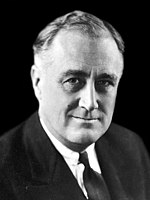| ||||||||||||||||||||||||||
| ||||||||||||||||||||||||||
 County results
| ||||||||||||||||||||||||||
| Elections in Alabama |
|---|
 |
|
|
The 1936 United States presidential election in Alabama took place on November 3, 1936, as part of the nationwide presidential election. Voters chose eleven representatives, or electors to the Electoral College, who voted for president and vice president. In Alabama, voters voted for electors individually instead of as a slate, as in the other states.
Since the 1890s, Alabama had been effectively a one-party state ruled by the Democratic Party. Disenfranchisement of almost all African-Americans and a large proportion of poor whites via poll taxes, literacy tests[1] and informal harassment had essentially eliminated opposition parties outside of Unionist Winston County and a few nearby northern hill counties that had been Populist strongholds.[2] The only competitive statewide elections became Democratic Party primaries that were limited by law to white voters. Unlike most other Confederate states, however, soon after black disenfranchisement Alabama’s remaining white Republicans made rapid efforts to expel blacks from the state Republican Party.[3] Indeed under Oscar D. Street, who ironically was appointed state party boss as part of the pro-Taft “black and tan” faction in 1912,[4] the state GOP would permanently turn “lily-white”, with the last black delegates from the state at any Republican National Convention serving in 1920.[3]
The 1920 election, aided by isolationism in Appalachia[5] and the whitening of the state GOP,[6] saw the Republicans gain their best presidential vote share in Alabama since 1884,[7] while the GOP even exceed forty percent in the House of Representatives races for the 4th, 7th and 10th congressional districts.[5] However, funding issues meant the Republicans would not emulate their efforts in the rest of the decade.[8] Nevertheless, a bitter “civil war” over how best to maintain white supremacy after the Democrats nominated urban, anti-Prohibition Catholic Al Smith saw so many Democrats defect to dry, Protestant Republican Herbert Hoover that he came within seven thousand votes of winning the state.[9]
However, the economic catastrophe of the Great Depression meant that this trend towards the GOP would be short-lived.[10] The Depression had extremely severe effects in the South, which had the highest unemployment rate in the nation, and many Southerners blamed this on the North and on Wall Street.[11] Consequently the South gave Democratic nominee Franklin D. Roosevelt extremely heavy support in 1932 — he became the only presidential candidate to sweep all of Alabama’s counties.[12]
For 1936, Roosevelt’s campaigning substantially moved away from the South — where almost none of the lower classes could vote — to focus on the working classes of the North and West.[13] However, this was clearly not going to affect his majority amongst an electorate who generally associated the Republican Party — even a lily-white Republican Party — with Reconstruction and black rule.[14] A poll in late September showed Roosevelt leading Republican nominee and Kansas Governor Alf Landon by four-to-one despite Landon leading the nation as a whole.[15] Another poll two weeks later saw the President’s lead falling slightly,[16] but this lead would be maintained in the last poll near the end of October.[17] As it turned out – like all the Literary Digest polls — Roosevelt’s strength was severely underestimated, for he actually won 86.38 percent of Alabama’s vote to Landon’s 12.82 percent, this being the best performance by a presidential candidate in Alabama since the largely uncontested elections of 1832.[12]
- ^ Perman, Michael (2001). Struggle for Mastery: Disfranchisement in the South, 1888–1908. Chapel Hill, NC: University of North Carolina Press. p. Introduction. ISBN 9780807849095.
- ^ Webb, Samuel L. "From Independents to Populists to Progressive Republicans: The Case of Chilton County, Alabama, 1880-1920". The Journal of Southern History. 59 (4): 707–736.
- ^ a b Heersink, Boris; Jenkins, Jeffery A. (2020). Republican Party Politics and the American South, 1865-1968. pp. 251–253. ISBN 9781107158436.
- ^ Casdorph, Paul D. (1981). Republicans, Negroes, and Progressives in the South, 1912-1916. The University of Alabama Press. pp. 70, 94–95. ISBN 0817300481.
- ^ a b Phillips, Kevin P. (1969). The Emerging Republican Majority. p. 255. ISBN 0870000586.
- ^ Heersink and Jenkins, Republican Party Politics and the American South, p. 19
- ^ Leip, Dave. "Presidential General Election Results Comparison — Alabama". Dave Leip’s U.S. Election Atlas.
- ^ See "G.O.P. Funds Are Reported Short: Forces "Counted On" Disappoint Republican Political Managers". The Birmingham News. Birmingham, Alabama. August 19, 1922. p. 5.
- ^ Feldman, Glenn (September 13, 2004). "Epilogue. Ugly Roots: Race, Emotion and the Rise of the Modern Republican Party in Alabama and the South". In Feldman, Glenn (ed.). Before Brown: Civil Rights and White Backlash in the Modern South. University of Alabama Press. pp. 270–273. ISBN 9780817351342.
- ^ Lewinson, Paul (1965). Race, class and party; a history of Negro suffrage and white politics in the South. pp. 167–168.
- ^ Ritchie, Donald A. (2007). Electing FDR: the New Deal campaign of 1932. Lawrence, Kansas: University Press of Kansas. p. 143. ISBN 070061687X.
- ^ a b Thomas, G. Scott (1987). The pursuit of the White House: a handbook of presidential election statistics and history. pp. 390, 418. ISBN 0313257957.
- ^ Ritchie. Electing FDR p. 186
- ^ Heersink; Jenkins. Republican Party Politics and the American South, pp. 48–50
- ^ "Literary Digest Poll Gives Landon 108,477 Votes in the Lead". Blaine County Booster. Dunning, Nebraska. September 24, 1936. p. 1.
- ^ "Presidential Poll Taken from the Radio, Wednesday". Blaine County Booster. Dunning, Nebraska. October 8, 1936. p. 1.
- ^ "Our Last Presidential Poll by Radio". Blaine County Booster. Dunning, Nebraska. October 29, 1936. p. 1.
© MMXXIII Rich X Search. We shall prevail. All rights reserved. Rich X Search


